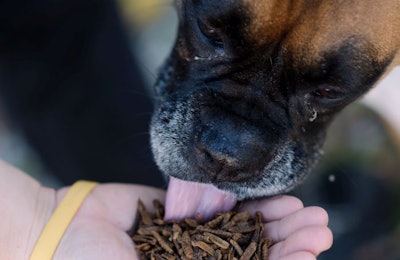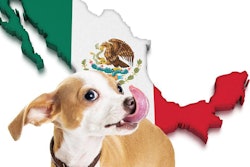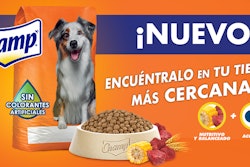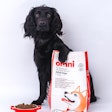
The British Veterinary Association has enthusiastically endorsed it as a pet food ingredient. Some experts project the market to increase exponentially in less than 10 years, soaring from production of about 10,000 metric tons today to 500,000 by 2030.
What is it? Insect protein, and if reality comes even close to meeting all the buzz about it (sorry for the pun), it could indeed become a market force and perhaps even pet diet staple in a relatively short time.
Pet food regulatory approval, production ramp-up
The headlines about insect protein, not only for pet food but for human food and that of other species, seem to come on a nearly daily basis. In January 2021, the Ingredient Definition Committee of the Association of American Feed Control Officials (AAFCO) approved black soldier fly larvae (BSFL) for use in adult maintenance adult dog food and treats, thereby giving the ingredient tacit approval by the Food and Drug Administration. (Full AAFCO membership approval is expected in August 2021, and BSFL’s use in cat food is on track to be approved in 2022.)
In the European Union, where approval of insects as pet food ingredients has proceeded more quickly, several dog foods using insects as a protein source have been on the market for several years. Recently pet food giants like Nestle Purina and Mars have joined the category, with the former launching a Beyond Nature’s Protein product in Switzerland in November 2020 that includes BSFL among its protein sources. In April 2021, Mars announced its own entrant, Lovebug, in the U.K. also using BSFL.
Black soldier flies are not the only insects being used in pet food, along with other foodstuffs; other increasingly popular species are crickets and mealworms. Also in April, Ÿnsect, a producer of mealworm ingredients based in France, announced its acquisition of Protifarm, a producer of human food ingredients made from mealworms. And EnviroFlight, based in the U.S., announced plans to develop an R&D center in North Carolina in 2022 to further develop its production and use of BSFL.
This follows on the heels of Enterra, based in Canada, opening its own large, commercial-scale BSFL production and research facility in British Columbia, in 2020, and Protix, one of the first BSFL producers in Europe, partnering with Buhler to create a large BSFL facility in the Netherlands in June 2019. (Buhler has since expanded into producing mealworms, too.)
Sustainability is key to insect protein success
At the time of Purina’s product launch in November 2020, my colleague, Tim Wall, noted that the entry of such a large market player seems to have spurred media attention to the category. Yet all the investment and R&D activity in the years preceding that announcement prove that many businesspeople and market watchers have been bullish on bugs for a while.
The main reasons for this increasingly popularity revolve around sustainability, first in the sense of being able to provide sustainable supplies of food, especially proteins, for pets and humans as populations increase globally and demand for protein rises in tandem. In terms of broader sustainability, including impact on the environment, insect production has been shown to use substantially fewer resources in terms of land, water and, to a lesser extent, energy, and also to create much less waste, than traditional livestock production.
In fact, insect excrement, known as frass, is also becoming a viable product for converting to biogas, while on the other end of the production stream, insects being raised for protein are often fed by-products from human food and other production streams that would otherwise go to waste. A company called Beta Hatch has even conducted DARPA-funded research showing that mealworms can safely consume mycotoxin-contaminated grains, thus turning materials that would have to be dumped into a new potential revenue source for growers or pet food companies.
Pet food projected to command significant share
The upshot of all of this? Of the 500,000 metric tons of insect protein production projected by Rabobank in 2030, pet food will rank as the second largest category, at 150,000 metric tons of production, behind only aquaculture’s 200,000. (Note that the Rabobank data seems to include insect proteins only for consumption by animals, including livestock like poultry and pigs; they do not include direct human consumption.) On its own, Ÿnsect expects its total annual production capacity to exceed 254,000 US tons of insect-based pet food ingredients after a third production facility, currently under construction, comes on line.
At the same time, research is ramping up to prove the nutritional benefits of insect protein to dogs and cats (part of the regulatory approval process but also proceeding on its own), along with consumer research on whether pet owners in Western markets like North America and Europe will accept insects as ingredients in the foods they buy for their beloved furry family members.
Wall cited a University of Pennsylvania study showing that U.S. pet owners were more willing to consider a pet food with something like insect flour versus dried whole insects. (Many of the insect protein products being used or studied now for pet food are in meal or oil form.) In all, 70% of the study participants were “willing to try insects in some form.”
(Bruce Jowett, director of marketing for Enterra, will present consumer research on acceptance of insect proteins among North American pet owners during Petfood Forum 2021 on September 23 in Kansas City. Virginia Emery, Ph.D., CEO of Beta Hatch, will also present her company’s mealworm research that day.)
If there is indeed reluctance among pet owners to consider pet foods with insect protein, it may be the only barrier to continued growth of the category as production scales to the point of making these foods more affordable. Yet, consumers are also demanding sustainability in the products and brands they buy, and with insect protein’s highly sustainable story to tell, that potential barrier may not stand for long.


















